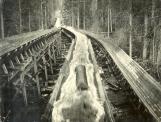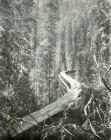15
By 1912, as accessible timber became more difficult to extract, the company constructed the Bear Creek flume. This flume stretched from Skmana Lake to the Lower Adams River, a distance of about 17.7 km (11 miles). and has the reputation of being the longest in Canada. Constructed of 1.5m (5 foot) wide, v-shaped heavy timbers, the flume was supported on trestles crossing ravines and canyons often 15-24m (50-80 feet) above the forest floor. Structurally engineered curves and precise grades ensured that logs being loaded at the storage pond could travel to their destination in 15 minutes, a rate of about 70 kph (44 mph).17
The Bear Creek Flume with a crew of men1912-1925
Adams Lake Area, British Columbia, Canada
 Credits:
Credits:Grant Munson
18
In 1918, an additional flume was built from Brennan Creek to Adams Lake. This flume was 1,8 km (6 miles) long and of similar construction. Once the logs reached Adams Lake they were towed to the splash dam before making their way to Shuswap Lake and the sawmill.19
Head of Brennan Creek Flume1918
Adams Lake Area, British Columbia, Canada
 Credits:
Credits:Walter F. Montgomery
20
Part way down the Brennan Creek Flume1919
Adams Lake Area, British Columbia, Canada
 Credits:
Credits:Walter F. Montgomery
21
By the early 1920's the costs of extracting timber and shipping the lumber became too high; the machinery and logging methods obsolete. In 1925 the company ceased operations. There was hope the company would re-open their doors when economic conditions improved, however, the equipment was slowly sold off and the sawmill buildings fell into disrepair. The sawmill buildings were sub-leased by smaller logging contractors for a time but the buildings were dismantled in 1947.Pole-loggers used the flumes but when the timbers began to deteriorate, local residents removed pieces of the flumes for building houses and outbuildings.
After nearly 20 years of employing hundreds of men and building a town, the only physical evidence of the existence of Adams River Lumber Company is glimpses of moss-covered flumes lying on the forest floor.




